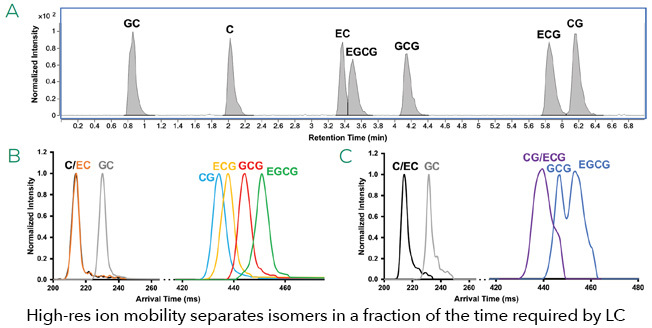
To demonstrate the utility of High-Resolution Ion Mobility (HRIM) to separate known epimers in green tea extracts.
Green tea is a beverage of broad interest due in large part to the presence of polyphenols in the leaves of Camellia sinensis.
The beneficial effects of green tea are attributed to the presence of number catechins, including non-esterified (+)-catechin (C), (-)-epicatechin (EC), (-)-gallocatechin (GC) and (-)-epigallocatechin (EGC) and the esterified (-)-catechin gallate (CG), (-)-gallocatechin gallate (GCG), (-)-epi- catechin gallate (ECG) and (-)-epigallocatechin gallate (EGCG).2 The four catechins that account for the majority of the components of green tea include EGCG, ECG, EGC, and EC with the potential of conversion to the non-epimeric forms during tea leave processing.3,4 As a result, it is necessary to evaluate epimerization during various physical processing to improve the nutritional value of green tea products. Although the catechin profile in green tea has been extensively studied, method agnostic characterization of the full catechin profile remains limited, representing a shortcoming in the study of health benefits of various epimers and processing impacts on epimerization.
The application of HRIM to food science provides several advantages including the separation of isobaric and isomeric compounds, potential increases in method sensitivity by reducing background noise, and the addition of collision cross section (CCS) as a complementary identifier to mass spectra. A seven-minute liquid chromatographic (LC) method was compared to a two-minute flow injection analysis (FIA) method on an Agilent 1290 and 6545XT Q-TOF equipped with the MOBIE® HRIM system from MOBILion Systems to analyze the standard catechin mix shown in Figure 1.





